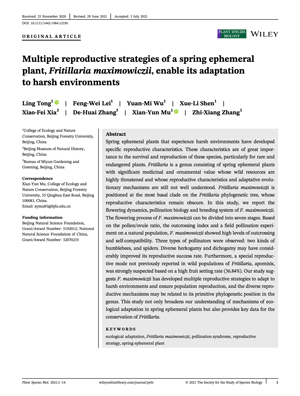NEWS 2021
Multiple reproductive strategies of a spring ephemeral plant, Fritillaria maximowiczii, enable its adaptation to harsh environments
Ling TONG1, Feng-Wei LEI1, Yuan-Mi WU1, Xue-Li SHEN1, Xiao-Fei XIA2, De-Huai ZHANG3, Xian-Yun MU1, Zhi-Xiang ZHANG1
Plant Species Biology 1-14 (2021)
https://doi.org/10.1111/1442-1984.12350
1College of Becology and nature Conservation, Beijing Forestry University, Beijing, China
2Beijing Museum of Natural History, Beijing, China
3Bureau of Miyun Gardening and Greening, Beijing, China
Abstract
Spring ephemeral plants that experience harsh environments have developed specific reproductive characteristics. These characteristics are of great importance to the survival and reproduction of these species, particularly for rare and endangered plants. Fritillaria is a genus consisting of spring ephemeral plants with significant medicinal and ornamental value whose wild resources are highly threatened and whose reproductive characteristics and adaptative evolutionary mechanisms are still not well understood. Fritillaria maximowiczii is positioned at the most basal clade on the Fritillaria phylogenetic tree, whose reproductive characteristics remain obscure. In this study, we report the flowering dynamics, pollination biology and breeding system of F. maximowiczii. The flowering process of F. maximowiczii can be divided into seven stages. Based on the pollen/ovule ratio, the outcrossing index and a field pollination experiment on a natural population, F. maximowiczii showed high levels of outcrossing and self-compatibility. Three types of pollinators were observed: two kinds of bumblebees, and spiders. Diverse herkogamy and dichogamy may have considerably improved its reproductive success rate. Furthermore, a special reproductive mode not previously reported in wild populations of Fritillaria, apomixis, was strongly suspected based on a high fruit setting rate (36.84%). Our study suggests F. maximowiczii has developed multiple reproductive strategies to adapt to harsh environments and ensure population reproduction, and the diverse reproductive mechanisms may be related to its primitive phylogenetic position in the genus. This study not only broadens our understanding of mechanisms of ecological adaptation in spring ephemeral plants but also provides key data for the conservation of Fritillaria.




